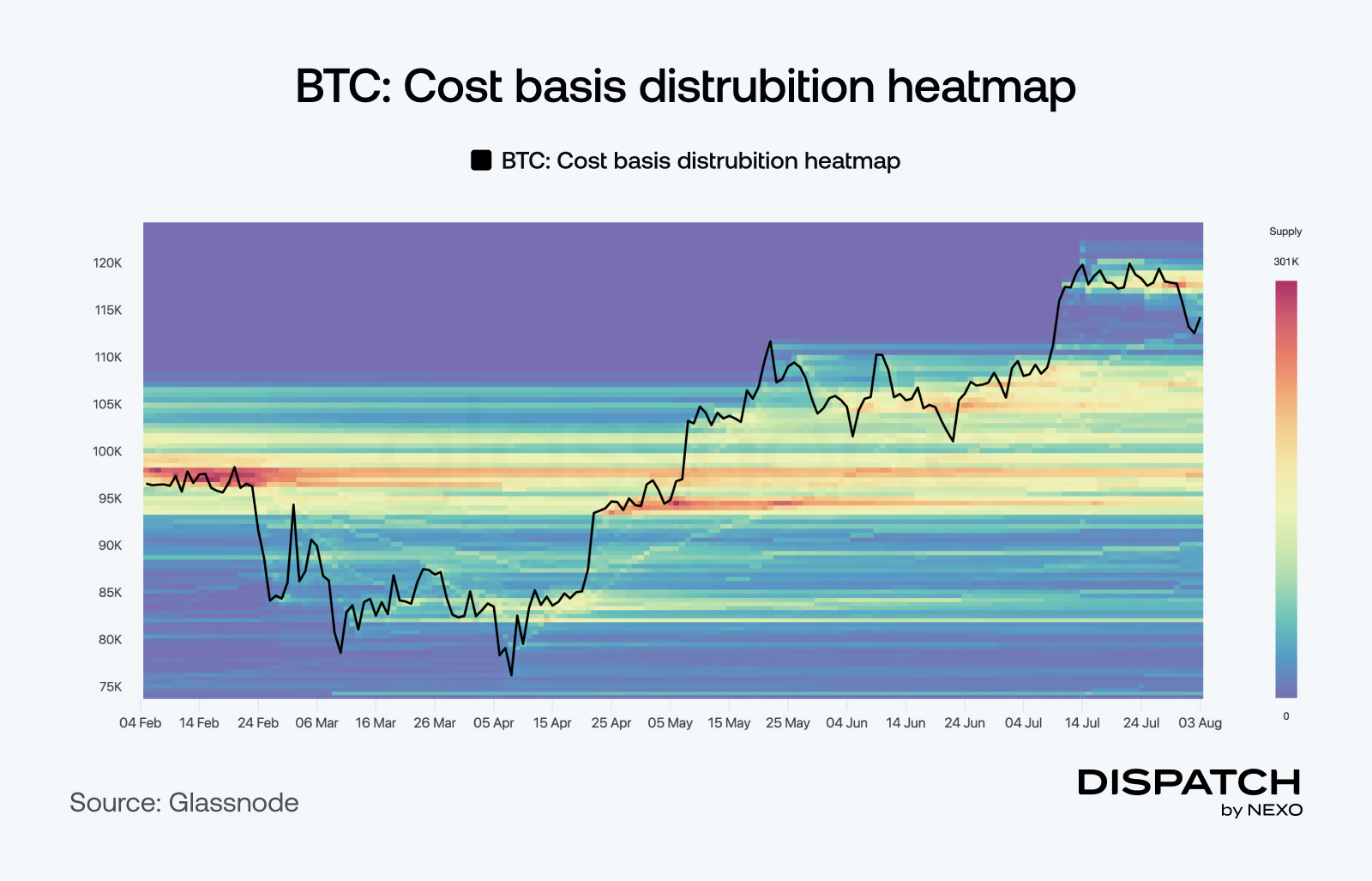Dispatch #256: Crypto’s back on home turf
Aug 05•6 min read

In this patch of your weekly Dispatch:
A crypto homecoming
Ethereum’s 10x potential
The Nexo Championship
Market cast
Momentum cools, but trend structure remains intact as Bitcoin tests its range
On the weekly chart, Relative Strength Index (RSI) and Stochastic oscillator readings are pulling back from overbought territory, suggesting some softening in momentum. Still, the Moving Average Convergence Divergence (MACD) remains in positive territory, and the Average Directional Index (ADX) continues to read above 25 — a level typically associated with a strong trend — indicating the broader uptrend hasn't lost steam.
On the daily chart, the price has slipped below the previous range’s lower boundary, now turned support around $117,000, with mixed indicators and signals. MACD has turned negative, ADX is weakening, and RSI hovers in neutral ground. The $120,000 region remains the key resistance to reclaim, while $112,000–$110,000 is emerging as a critical support zone – especially in light of the cost-basis air-gap highlighted in this week’s data story.
With macro signals mixed and policy clarity improving, the market is watching for cues – but not rushing to break out just yet.
The big idea
“Crypto, Welcome Home.” What the U.S. said – and what Nexo did
Last week, the U.S. Treasury Secretary Scott Bessent posted three words that would've sounded unthinkable just a year ago:
“Crypto, welcome home.”
Alongside that message came a 168-page White House report from President Donald Trump’s Working Group on Digital Asset Markets — a detailed blueprint to reestablish U.S. leadership in crypto and blockchain.
The report calls for giving the Commodity Futures Trading Commission (CFTC) clear authority to regulate crypto spot markets, ensuring better oversight and investor protection. The framework also proposes safe zones and faster approval processes for launching new tokens, encouraging innovation without pressure. Banking rules to be modernized, ending unofficial efforts to restrict crypto companies’ access to banks (often referred to as “Operation Choke Point 2.0”) and allowing banks to offer services like crypto custody and stablecoin issuance. Last but not least, there’s a national push to support dollar-backed stablecoins, supported by legislation like the GENIUS Act, to strengthen U.S. leadership in digital finance.
Where policy begins, progress takes action. And at Nexo, we’ve already taken the first steps.
Earlier this year, we announced our return to the U.S. market at an event with Donald Trump Jr. On July 29 – just days before the White House report’s release – President Trump personally inaugurated the brand-new course for the upcoming Nexo Championship in Scotland, joined by Nexo’s founders and senior leadership.
A new era begins.
From policy clarity to public trust, from tokenization to tournaments, we see where the future is headed. With a U.S. blueprint that includes market structure reform, stablecoin adoption, and modernized banking rules, the path forward is becoming clearer – and if this is how we enter the world of golf, you can only imagine where we’re headed next.
Bitcoin
Global wealth and the IMF
Bitcoin ended July at $115,644 – its highest monthly close in its 16-year history – as new IMF-backed standards put crypto into the world’s financial ledgers. That’s despite one of the biggest notional Bitcoin sales – the transfer of 80,000 BTC, or over $9 billion based on then market prices, for a Satoshi-era investor— a move the market absorbed with striking efficiency.
That confidence now has statistical legitimacy. For the first time, Bitcoin and other crypto assets will be included in national wealth data, thanks to updates to the System of National Accounts (SNA) – the global framework used to track national economic performance. Coordinated by the IMF, the changes will classify eligible crypto holdings as “non-produced nonfinancial assets.”
While crypto won’t count toward GDP, the update means Bitcoin will now appear on sovereign balance sheets, placing it alongside more traditional forms of national wealth. Translation: even if they won’t say it, the IMF just admitted that crypto counts.
Еthereum
Treasuries and tides
Last week, Ethereum closed out its strongest ETF streak to date: 20 consecutive days of net inflows in July totaling nearly $5.4 billion, surpassing all previous runs in both length and volume. Spot ETH ETFs have now seen inflows in 12 straight weeks, with just nine outflow days in the past three months, reinforcing ETH’s growing foothold among institutional allocators.
At the same time, Ethereum treasury holdings are booming. Since June, corporate buyers have accumulated 1.26 million ETH – 1% of total supply – nearly matching ETF inflows. Standard Chartered expects that figure to 10x, reaching 10% of all ETH in circulation.
Driving this trend: firms like BitMine, now the world’s largest public ETH holder with 833,000 ETH worth $2.9 billion, backed by ARK Invest and Peter Thiel’s Founders Fund. Treasuries are betting not just on price, but on ETH’s unique utility: staking yields, DeFi access, and programmability.
TradFi trends
U.S. capital markets x blockchain
Last week, SEC Chair Paul Atkins unveiled Project Crypto, a broad effort to modernize securities regulation for digital assets. The initiative will introduce clearer rules around token classifications, custody, and trading – with an emphasis on supporting tokenized assets. The SEC also signaled openness to DeFi platforms operating within regulated frameworks and called self-custody “a core American value.” It took the U.S. CFTC one business day to in turn announce a “Crypto Sprint,” an initiative to actualize recommendations from the digital asset report from President Trump’s working group.
Analysts at Bernstein described Project Crypto as the boldest shift in U.S. crypto policy to date, comparing its ambition to past financial turning points like electronic trading in the 1990s. In their view, it lowers long-standing barriers to entry and opens a path for new players – from fintechs to decentralized protocols – to participate in capital markets. The message: American financial infrastructure is beginning to move from online to on-chain. WDYT?
Macroeconomic roundup
Services, rates, and labor
A seemingly lighter macro calendar, but with key tests for services, rates, and labor.
U.S. ISM Non-Manufacturing Purchasing Managers Index (Aug 5): Forecast to tick up to 51.1%, this closely watched gauge of U.S. services activity could either dampen or accelerate rate-cut bets depending on whether it lands above or below expectations.
U.K. Interest Rate Decision (Aug 7): Markets expect a cut to 4.00% as inflation cools and growth stalls, but internal divisions at the BoE underscore the uncertain path ahead for UK monetary easing.
U.S. Initial Jobless Claims (Aug 7): A modest rise to 221,000 is expected, reinforcing labor market softness that could weigh on the Fed’s tightening bias – and potentially support Bitcoin’s macro setup.
The week’s most interesting data story
Anchored at the top
Bitcoin’s Cost-Basis Distribution reveals a dense cluster of investor accumulation between $117,000 and $122,000 – a sign that recent buyers are entering with conviction, even at elevated levels. Just below, the chart shows a light volume zone from $115,000 to $110,000, a result of the rapid rally that offered little time for transactions. While not all such gaps invite pullbacks, they can become areas the market revisits to confirm support. For now, Bitcoin appears well-anchored near all-time highs, with buyers showing resilience even as macro signals remain mixed.

The numbers
The week’s most interesting numbers
$10 billion – Strategy’s Q2 2025 net income, driven by BTC price gains.
17,595 BTC – Metaplanet’s BTC holdings after their latest purchase.
$1.3 billion – Unrealized Bitcoin gains as investors resist selling pressure.
Hot topic
What the community is discussing
A phrase once unimaginable.
It’s tee time, we told you.
Three years and counting.
Dispatch is a weekly publication by Nexo, designed to help you navigate and take action in the evolving world of digital assets. To share your Dispatch suggestions and comments, email us at [email protected].
